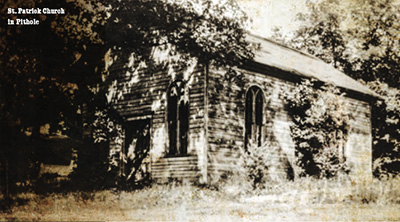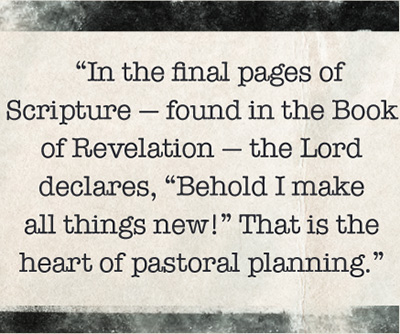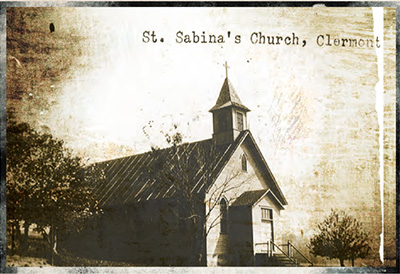
Ever ancient, ever new
by Father Justin Pino, archivist for the Diocese of Erie
09/19/2023
INTRODUCTION
In his classic work The Confessions, St. Augustine describes his love for God as “beauty ever ancient, ever new.” At the Second Vatican Council, Pope St. John XXIII used the guiding principle of aggiornamento (Italian for “updating”) to describe the work of the Church to remain young and vibrant in speaking the truth and beauty of the Gospel to the people of this age and to every age. Yet the practice of updating and renewal has been ever-present in the life of Christ’s church from the beginning. During this time in the history of the Diocese of Erie, when pastoral planning has become essential to the life of our local church, when parish closures, partnering and merging are realities, it is essential to recognize these “new ways of possibility” are far from new. In fact, the historical record shows the Diocese of Erie has been practicing pastoral planning for nearly 150 years!
Reform and renewal involve change. The late Father Charles Irvin, M.Div., J.D., a seasoned priest and pastor from the Diocese of Lansing, Michigan, puts change within the context of the life of the church.
He said: “Life is filled with change. It seems that the only constant in life is change. Beginning with the Book of Genesis right on through to the Book of Revelation, God calls us to accept change. He continually calls us to a ‘change of heart,’ to conversion, to acceptance of his ways, ways that are not our ways. Anyone with the slightest knowledge of church history recognizes the life-changing Holy Spirit present in Christ's mystical body. Likewise, all who study world history, regardless of whether or not they are people of faith, recognize the ever-changing experience of the church both internally and externally. Indeed, if through-out the centuries the church had not changed; it would not be what it is today.”
Let us look at those who have gone before us marked with the signs of faith and renewal from the Diocese of Erie of yesterday. The past can inform and reinforce that the pastoral planning process of today is a true extension of the living church in the 13 counties of northwest Pennsylvania that began when our diocese was established in 1853.
CHANGE IS NOT NEW
Have you ever been to Bear Lake? How about a Sunday drive through Morganland? Had an opportunity to pray at St. Anthony Church in Custer City or attended Mass in Clermont? The answer is ... probably not. These places, which are all located within our diocese, have faded into the footnotes of history. Every county in the Diocese of Erie has a parish, church or even towns themselves that have either closed, been merged into another faith community or have disappeared.
We can see that every county in the diocese has undergone ecclesial change. According to available historical records, there have been more than 140 parishes, churches or missions that have experienced what we call pastoral planning. When was this first instance of this reform, you may ask? The answer may surprise you. It was in 1866. Yes, this process has been unfolding within our diocesan community for 157 years! When the Diocese of Erie was just 13 years old, St. Mary Church, in what was called Maguire’s Settlement in Crawford County closed. It had been established only 11 years earlier. The exact circumstances of the closure and relocation of the faith community elsewhere are not known, but demographic, geographic and personnel issues were as prevalent in the aftermath of the Civil War as they are today. These factors in the vitality and life of a faith community are essential indicators today as we continue to journey along the path of pastoral planning.
COMING TOGETHER AS ONE
Parish mergers, too, have been occurring in our diocese since long before 2015. The first major parish merger occurred at Farrell in 1952. Spearheaded by Msgr. Geno J. Monti, St. Elizabeth Parish, historically Irish, was merged with St. Anthony of Padua, the Italian parish. The community combined to form Our Lady of Fatima Parish (the old St. Elizabeth church building). For many years after, Farrell had three additional churches: St. Adalbert, Holy Trinity and St. Ann. Today, Our Lady of Fatima remains as the lone Farrell parish — the community that first made unity a priority in 1952.
Houtzdale in Clearfield County also saw a need to merge in 1970. Three parishes of separate ethnic heritage — St. Lawrence (Irish), St. Barbara (Polish) and Sacred Heart (Slovak) — came together as Christ the King Parish under the dauntless leadership of Father Leonard Kuziora. Visiting Christ the King, it’s possible to see this merger today, 53 years later: statues of the former parishes adorn the sanctuary of the patron saints of the former parishes, stained-glass windows also are from all three former churches. Outside the church are the bells of the three churches and parts of the church building itself are walls from the original Sacred Heart Church.
In more recent times, St. Cyprian and St. Matthew in the Woods churches formed a new parish in 2005 and constructed a beautiful church building in honor of All Saints in Waterford. The outlying churches of Walston, Anita and Delancey merged with SS. Cosmas & Damian Parish in Punxsutawney in 2010 as missions; they closed a decade later. The Epiphany of Our Lord Parish in Meadville, formed from St. Agatha, St. Brigid and St. Mary parishes, is the latest merger of parishes in 2021. Parishioners there have followed in the footsteps and embraced the Holy Spirit’s promptings, as did the priests and people of Farrell and Houtzdale.
In the spirit of new beginnings, as seen in Houtzdale and Meadville, faithful have started their new chapters of unity with new patronal names for their communities. This, too, is not a new practice. St. Leo Magnus Parish in Ridgway began its life as Our Lady of the Sacred Heart when the Benedictine Fathers from nearby St. Marys cared for the Catholics in Ridgway until a resident pastor was appointed in 1874. When a church was built that year, a new patron was chosen. A number of other examples in the annals of diocesan history illustrate this thread of renewal. Catholic schools, too, have witnessed this, especially seen in 1962 when the regional high schools were being completed. Shenango Catholic High School, which was then changed to Shenango Christian in the spirit of the ecumenical outreach of Vatican II, then became Kennedy Catholic following delayed construction and the assassination of the president in 1963. Even names of towns have changed through the years. For example, Vogelbacher became Lucinda and South Sharon eventually became Farrell.
RENAMING OR MERGING AN ENTIRE DIOCESE?
Dioceses as a whole have merged, changed their names and even been suppressed. The Diocese of Bardstown, Kentucky, became the Diocese of Louisville, Kentucky, when population necessitated the relocation of the See City, as did the Diocese of Natchez in Mississippi, which is now called the Diocese of Jackson. The Diocese of Walla Walla, Washington, later called the Diocese of Nesqually, merged into what is now the Archdiocese of Seattle in Washington state in 1907. In Pennsylvania, the Diocese of Allegheny had existed from 1876, when it was separated from the Diocese of Pittsburgh, until it was suppressed (closed) and reunited with Pittsburgh in 1889. In 1930, the Diocese of Lead was renamed the Diocese of Rapid City in South Dakota. As recently as 2020, Pope Francis united the Alaskan Diocese of Juneau and the Archdiocese of Anchorage to form a single church now called the Archdiocese of Anchorage-Juneau under one shepherd. We can see that what has been unfolding here in the Diocese of Erie since the 1860s has been a living process throughout the diocesan churches of our country for as many years.
CONCLUSION
At present, a number of parish communities throughout the Diocese of Erie have undergone some degree of pastoral planning. Others are actively considering and planning what the future of the faith will look like for the next generation of Catholics. History continues to show us the challenges, processes and outcomes are not new, but always changing, always in search of renewal. In the final pages of Scripture — found in the Book of Revelation — the Lord declares, “Behold I make all things new!” That is the heart of pastoral planning. That is what St. Augustine saw in the beauty of God’s loving presence — ever ancient, ever new. Whether a faith community comes to realize that it must change, partner, merge or move on to another place, our shared history reminds us quite clearly that this is not an end, but a new beginning. Though Jesus speaks of this newness in the last book of the Bible, we know and we believe it is just the beginning — a new life.
The Diocese of Erie is not 170 years old — we are 170 years new! The Father’s creative love — Jesus’ abiding presence among us — and the Holy Spirit’s continual guidance are simultaneously ancient and new. Our diocese — our parishes — and our individual and communal faith experiences are ever changing, ever renewing, ever recognizing the Trinity’s work within and among us and ever affirming us to serve and love God’s holy church in different ways. As our diocesan pastoral planning prayer reminds us: “We pray for the vision to see new paths of possibility, a spirit of mission that invigorates our every effort, and for the strength to be unafraid of what is new.” What we have embarked upon, as our own history tells us, is not so much new, but a continuation of our mission as Catholic Christians in this portion of the Lord’s vineyard. Our ancestors in the faith accepted the challenges of pastoral planning and moved forward with unity, trust and hope. We continue their mission as part of our own today. Yes, we have stood on the shoulders of brave faith-filled giants. Let us strengthen ourselves, that we may continue building a strong foundation for ourselves and for those who will inherit the legacy we create.
-
